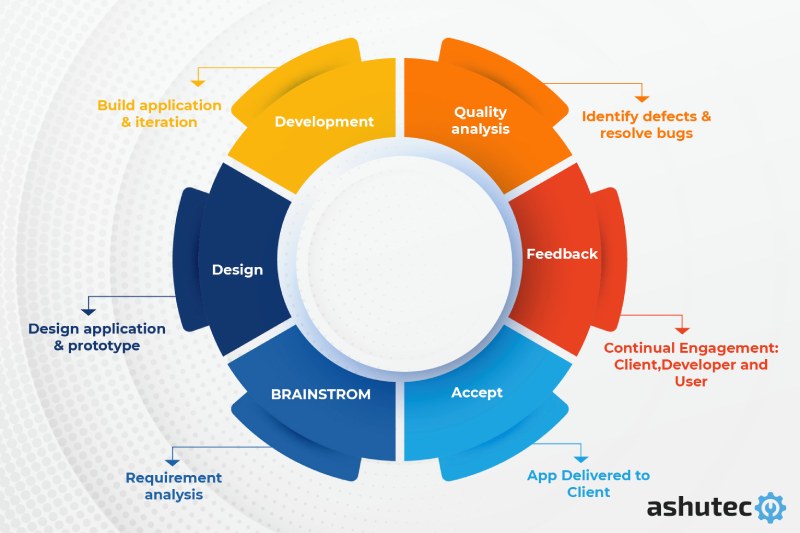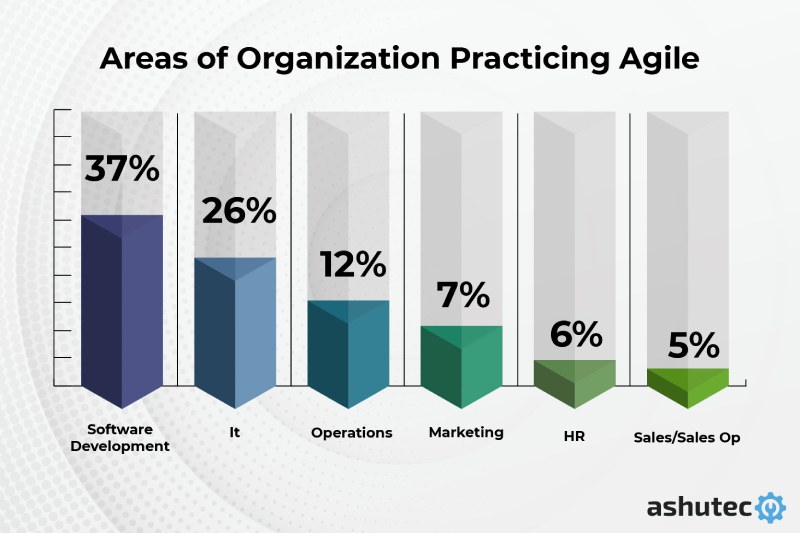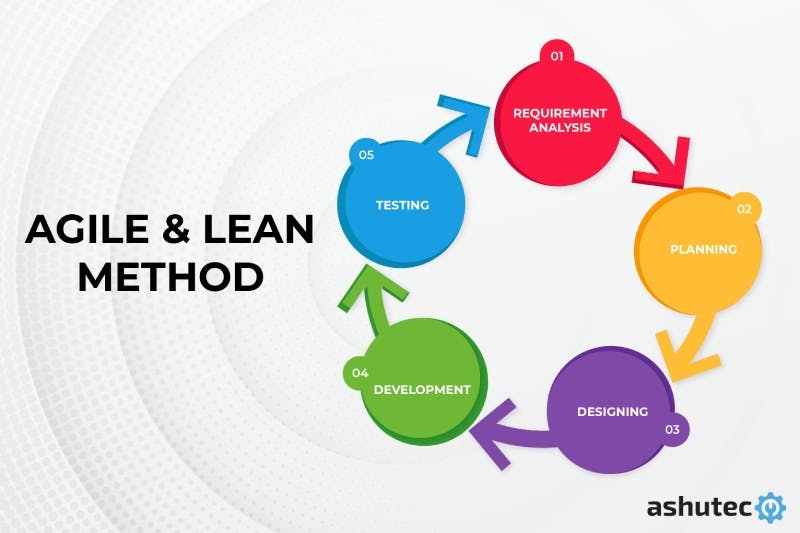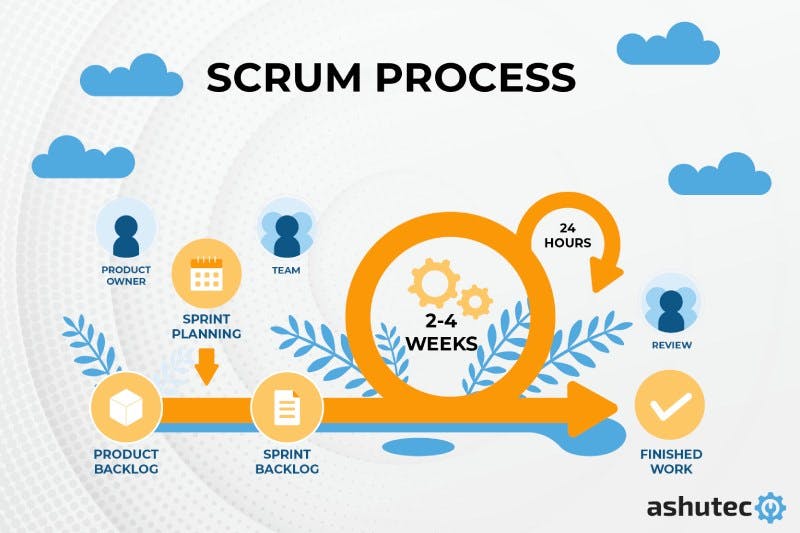Let’s Connect!
Work can be a fun when we know and understand each other well. Let's start conversation to new beginning
+91 63542 35108
To discuss what we can do for you Give us a Call
connect@ashutec.com
Tell us about your next project Write to us

The software can be developed and produced in a variety of ways according to the scope of modern software development. The process and methodology used to develop a software product make up the scope to which we are responding.
On that topic, the terms lean, agile, and scrum have recently gained popularity among software developers. Although the industry has been using these notions in practice for some time, there are still some misunderstandings about what they involve. Many people learn about agile approaches in collaboration with SCRUM or lean, and because they incorrectly link the three together, they become confused. But, each has unique roles and responsibilities, so it's critical to understand what each one accomplishes.
Many managers already use the terms agile, scrum, and lean in their daily work. And in this regard, understanding the differences between agile methodologies is essential so that the business may select the option that best fits its profile.
In today's project management environment, the Agile Scrum methodology is one of the most broadly utilized techniques. Several companies from a wide range of industries are being driven to use the Agile development methodology in their regular work processes by the advantages the method offers, including improved business value, quicker time to market, greater team transparency, and better quality management.
Software development that is iterative is known as "Agile development." The DevOps life cycle is shortened through iterative software development by completing work in brief bursts, sometimes known as sprints. Sprints usually last one to four weeks. Traditional or waterfall development, which lays out larger projects in advance and performs them in conformity with the plan, is frequently compared with Agile development.

Agile development teams must adjust to a faster pace to deliver code that is ready for production at the end of each sprint. Every sprint must include all coding, testing, and performance measurement. A team's performance may not live up to expectations if it is not properly organized. Even while these obstacles present wonderful learning opportunities, it's helpful to understand a few fundamental lessons beforehand.
Many software programs, including messaging apps like WhatsApp, Telegram, and Google's messaging services, can be developed using the agile methodology.
Since messaging apps frequently require frequent updates and changes to meet user expectations and remain competitive, an agile approach is well suited for their development. The agile methodology enables messaging app development teams to react fast to changing user needs, market trends, and emerging technologies by breaking development down into smaller, smaller portions.
Agile is a continual software development method that allows requirements to be provided throughout the process rather than all of them at the end. The primary principles of this approach to software development are teamwork, client engagement, and flexibility.
Agile software development is a methodology that is more than just frameworks like Scrum, Extreme Programming, or Feature-Driven Development(FDD). Agile software development involves more than just techniques like test-driven development, stand-ups, meetings, performance tuning, and sprints.
Agile differs from other methods of software development in part because it places special emphasis on the people doing the job and their interactions with one another. Collaboration between self-organizing cross-functional teams using best practices for their environment leads to solutions.

Here are some benefits of agile development :
Customer satisfaction: Understanding and meeting the requirements of the end user are given top priority in Agile software development. The Agile methodology ensures that the software being developed satisfies the specific requirements of the end user by involving customers throughout the development process and delivering functional software in compacted iterations. Higher adoption rates and better customer satisfaction may result from this.
Flexibility and adaptability: Agile software development's capacity to react swiftly to evolving requirements or feedback is one of its main benefits. Teams can shift and adjust to changing circumstances because Agile projects are divided into small, manageable tasks that are finished in brief iterations. This implies that as the software is being developed, it can change and advance, producing improved results.
Teamwork and collaboration: Agile encourages a culture of teamwork and collaboration, which can improve communication and result in a common grasp of project objectives. Agile makes sure that everyone is pursuing the same objectives by including all team members in the development process and by promoting regular contact and feedback. Teams at ashutec function more effectively and quickly as a result.
Faster time-to-market: Agile development, with its emphasis on producing usable software in brief rounds, can hasten the release of new features and functionality. This is due to the fact that each iteration produces some useful software that can be tested and published, as opposed to delaying delivery until the entire project is finished.
Reduced risk: Agile can lower the risks of project failure or delays by breaking a project down into smaller, more manageable tasks. This is due to the fact that managing a smaller number of tasks is simpler than managing a larger undertaking. Focusing on customer feedback can also lower the risk of creating software that doesn't meet customer requirements because changes can be made earlier rather than later in the development process.

The goal of the lean development approach is to reduce waste and increase productivity throughout the software development process. It is founded on the ideas of lean manufacturing, which were developed in the 1940s in Japan with the introduction of the Toyota Production System. Both app development and web development can benefit from lean development principles.
Lean development aims to develop a simplified, effective process that offers value to consumers while generating the least amount of waste possible. Value stream mapping, just-in-time delivery, and an emphasis on continuous improvement are used to achieve this. Lean concepts are used in software development at every step of the process, from planning and design to testing and deployment.
Reduced waste: Lean development helps teams work more productively and efficiently by identifying and eliminating waste in the development process. Rework, flaws, and pointless features are a few examples of waste. Teams may maximize resource use and concentrate on providing value to the client by decreasing waste.
Continuous improvement: Lean Development promotes a culture of continuous improvement through regular retrospectives and process reviews. Teams can use this to pinpoint areas for development process improvement and implement iterative changes over time. Teams can increase their productivity and effectiveness in the delivery of software by iteratively improving their methods.
Faster time-to-market: Lean Development delivers features and functionality just in time, which can support teams in speeding up the time it takes to bring products to market. Particularly in sectors where time-to-market is important, this can be advantageous. Teams can acquire a competitive advantage and increase market share by prioritizing the most important aspects and providing them as soon as possible.
customer satisfaction: Lean Development places a strong emphasis on providing value to customers, which can result in an increase in customer satisfaction. Teams may enhance their interactions with their consumers and increase their overall satisfaction with the product by delivering features and functionality that respond to their demands. These may bring more sales and better client loyalty.
Collaboration: Collaboration will increase because Lean Development places a strong emphasis on teamwork and communication, which can assist to reduce silos and encourage cross-functional work. A more integrated and effective development process may result from this. Teams can produce better products more rapidly by cooperating and sharing information and resources.
Effective use of resources: Lean Development can assist teams in making the most of their resources by reducing waste and enhancing efficiency. This may result in reduced expenses, fewer delays, and an all-around more efficient development process. Teams may produce high-quality software in less time and with fewer resources by concentrating on providing value to the client and continuously improving their processes.
Scrum is an agile software development framework that prioritizes collaboration, communication, and increased rate. Jeff Sutherland and Ken Schwaber first launched it in the early 1990s to develop a simple, adaptable framework that would aid software development teams in producing high-quality products rapidly and effectively. A perfect framework can help you build secure software.

Three essential functions of the Scrum framework: the Product Owner, Scrum Master, and Development Team. The Product Owner is in charge of creating the product backlog and making sure the team works on the most important tasks first. The Scrum Master is in charge of making sure the groups utilizing to the Scrum framework and remove any barriers that might be impeding development. After each sprint, the Development Team is in charge of providing a potentially shippable increment of the product.
Some important objects used in Scrum are used to manage and organize work. The Product Backlog, Sprint Backlog, and Increment are some of these objects. All the work that has to be done on the product is included in the product backlog with a priority order. The team commits to working through the items on the Sprint Backlog, a portion of the Product Backlog, during the following sprint. The Product Backlog items completed throughout the sprint are added up to create the Increment.
Sprint Planning: The team organizes the work that will be completed during the sprint during this meeting, which takes place at the start of each sprint. The team looks over the product backlog, chooses the tasks for the sprint, and builds a sprint backlog. This makes ensuring that the team is on the same page regarding the sprint's priorities and objectives.
Daily Scrum: This is a short meeting that is held each day of the sprint to discuss progress and identify any potential roadblocks. Coordination and communication are the main topics of this meeting. The team can work together to effectively fix any difficulties by keeping everyone in the loop and informed.
Sprint Review: This is the gathering that takes place after every sprint to review the work completed and collect input from stakeholders. The team presents the operational software created during the sprint and obtains input from stakeholders. This makes ensuring that the team is satisfying stakeholders' requirements and providing value.
Sprint Retrospective: This is the gathering that takes place after each sprint to review the process and identify areas that could want improvement. The team discusses what went well, what didn't, and how to make the process better for the upcoming sprint. This makes it possible for the team to keep getting better and gain knowledge from every sprint.
Product Backlog Refinement: This process requires updating the product backlog over the course of the sprint. Based on new information or input, the team and the product owner collaborate to add, remove, or reorder products. By doing so, it is possible to guarantee that the team is working on the most important tasks first and that the product backlog is constantly updated.
The Scrum framework has gained widespread acceptance throughout the world and is frequently used in software development. It places a strong emphasis on teamwork, communication, and iterative progress and is created to be flexible and adaptable to the demands of any team. Teams may deliver high-quality products fast and effectively while continuously improving their procedures by adhering to the Scrum framework.
Agile, scrum, and lean are one of the top frameworks for software development, here are some key differences between them:
Technique: Agile is a generic approach to software development that places an emphasis on adaptability, teamwork, and iterative development. In other words, the Agile framework is created to be flexible and able to be adjusted to the demands of the team and the project. Agile emphasizes collaboration and communication among team members and stakeholders to make sure that the software being created satisfies their needs and specifications. Agile also places a strong emphasis on an iterative process in which software is built incrementally rather than all at once.
Team Format: Agile and Scrum both place a strong emphasis on cross-functional teams that collaborate to produce high-quality software. In Scrum, the team self-organizes, with the assistance of a Scrum Master who oversees the operation. This means that to accomplish the project's objectives, the team must organize itself, manage projects, and cooperate. Cross-functional teams are emphasized by lean, although the emphasis is on increasing value and avoiding waste rather than on specific roles and tasks.
Process: Scrum and Agile both emphasize the importance of an iterative method that enables teams to continuously improve and adjust to the needs of the business. Software is created in modest, incremental steps with frequent testing and feedback, according to this. Lean prioritizes reducing waste and optimizing processes to boost productivity and efficiency. So, Lean places a strong emphasis on eliminating phases and procedures that don't add value to the finished product.
Feedback: Regular team and stakeholder communication is a top priority for both Agile and Scrum. To guarantee that the software being created satisfies their needs and specifications, the team and stakeholders collaborate closely. Lean promotes input as well, but the goal is to obtain feedback rapidly to reduce waste and increase value. To make sure that the team is creating the proper product, Lean emphasizes obtaining input early in the development process.
Principles: The Agile Manifesto, on which Agile is founded, values people and interactions, functional software, customer collaboration, and adapting to change. This indicates that Agile places a higher importance on people and their relationships than it does on tools and processes, working software over thorough documentation, customer collaboration over contract negotiating, and adapting to change over sticking to a plan.
Scrum is built on the principles of transparency, inspection, and adaptation. This indicates that Scrum places a focus on responding to shifting needs and input, regular inspection of the work being done, and transparency in the process and progress. Continuous improvement, respect for people, and reducing waste are the foundations of lean. To boost production and efficiency while valuing people and their contributions, Lean emphasizes continuously improving the process and decreasing waste.
Agile, Scrum, and Lean are all software development frameworks, each with a special focus and method. Lean stresses avoiding waste and maximizing value in the software development process, while Agile emphasizes adaptability, cooperation, and iterative progress. Scrum offers a set of rules and procedures for managing and carrying out a software development project. Depending on the needs and objectives of the team and organization, one framework may be chosen over another.
As a software company, ashutec can benefit from adopting one or more of these frameworks to improve its software development process. Ashutec can operate more productively, create software products of higher quality, and better satisfy the needs of its clients and stakeholders by adopting Agile, Scrum, or Lean concepts. ashutec can remain competitive in the quick-paced software development industry by consistently streamlining its development process and concentrating on providing value to its clients.

